Close-ended questions: When to use them and why
What’s a close-ended question and how do you get quantitative data? Here’s what to know, including question examples, survey examples, and more.
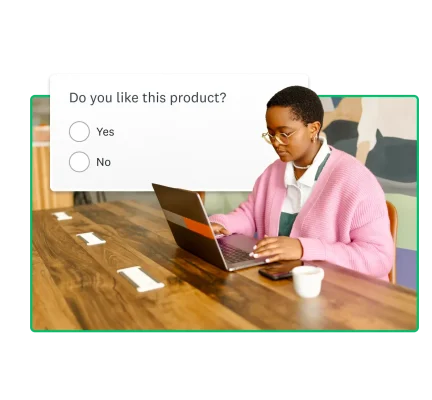
Close-ended questions are a critical part of a researcher’s toolbox, especially if they want to pinpoint trends over time. From multiple-choice questions to ranking questions, from market research to employee surveys, closed-ended survey questions are all about gathering specific data for analysis.
Let’s dive into what you need to know about close-ended questions, including why they’re important, what close-ended question types are most common, and how you can use them.
What is a close-ended question?
Closed-ended questions, are questions with pre-determined answer options.
They ask respondents to select from a predefined set of answers — typically “yes/no,” “true/false,” or multiple-choice options on a rating scale.
These questions don’t allow for open-ended input or elaboration. Instead, respondents choose the answer that most closely matches their opinion, even if it doesn't capture their thoughts in full.
Here's an example:
“On a scale of extremely satisfied to extremely dissatisfied, how would you rate your recent experience with our customer service?”
The purpose of close-ended questions is to gather quantitative data — measurable responses that can be easily grouped, compared, and analyzed. This makes it easier to spot patterns, identify trends, and track changes over time.
Researchers favor closed-ended formats when they need statistical significance and structured data to guide decision-making or show progress.
10 types of close-ended questions with survey examples
Whether you're looking to conduct market research, improve customer satisfaction, or boost employee engagement, you likely need to ask some closed-ended survey questions to get quantitative data.
There are many question types that fall under the umbrella of closed-ended questions—and they can be useful in different ways.
Let’s walk through some common close-ended question types and how they might be used in specific survey examples.
1. Closed-ended multiple-choice questions
Multiple-choice questions are a popular type of close-ended question that allows survey respondents to select an answer from a list of choices. They’re a low-effort way for respondents to indicate everything from their demographics to their opinions or habits.
Multiple choice questions are often the foundation of Customer Satisfaction (CSAT) surveys, where customers are asked to rate their satisfaction with a company, product, or experience.
Here’s an example of how this multiple choice closed-ended question might look in a CSAT survey:
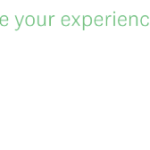
This close-ended question format gives you numerical data for statistical analysis—revealing how satisfied your customers are with your product.
2. Closed-ended rating scale questions
Close-ended questions that ask respondents to choose from a set scale of answer options are called rating scale questions, or ordinal questions. The range of a rating scale can vary (0 to 100, 1 to 10, etc.), and respondents select the number that most accurately represents their opinion.
Customer experience (CX) metrics tend to rely on close-ended rating scale questions. For example, the Net Promoter Score (NPS®) question uses a rating scale to measure customer loyalty or, in the case of employee Net Promoter Score (eNPS), employee satisfaction.
Here’s how this rating scale question appears in an NPS survey:
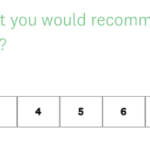
The close-ended rating scale is essential for calculating your NPS—you won’t get your score without it.
3. Closed-ended Likert scale questions
The Likert scale is a type of rating scale that measures respondents’ opinions, attitudes, motivations, and more. You’ve probably come across a Likert scale close-ended survey question if you’ve been asked how much you agree or disagree with a certain statement.
For example, in employee feedback surveys, employees might be asked to rate how much they agree or disagree with statements like:
- Employee engagement survey: “I feel adequately supported by my supervisor.”
- Belonging and inclusion survey: “When I speak up at work, my opinion is valued.”
- Career development survey: “I am satisfied with my opportunities for professional growth.”
- Workplace benefits survey: “I am satisfied with the amount of paid leave offered by my organization.”
The quantitative results from these close-ended rating scale questions could help an HR professional understand and track the employee experience and make data-driven improvements.
4. Closed-ended matrix questions
Matrix questions are a way to ask respondents several related questions in a row while keeping the same scale of answer options. A series of Likert scale questions or rating scale questions are often used as a matrix question.
Matrix questions are handy for market research since they can be used to consolidate questions and gain lots of data. However, the trick is to make sure that your matrix isn’t too complex or lengthy.
Here’s an example of a matrix question that could be found in a market research survey:
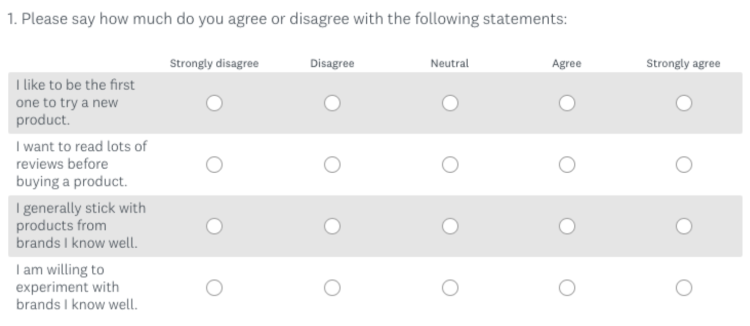
5. Closed-ended dropdown questions
Dropdown questions are a simple and effective way of offering a long list of scrollable answer options without overwhelming your respondents. Think of it this way: If you’re a marketer conducting research on American consumers and need to know where respondents are located, listing out every state and territory may take up valuable survey space—but a dropdown question would save the day.
In fact, you’ll often run into dropdown questions that ask for demographic information like birth year, nationality, or level of education. Here’s an example:
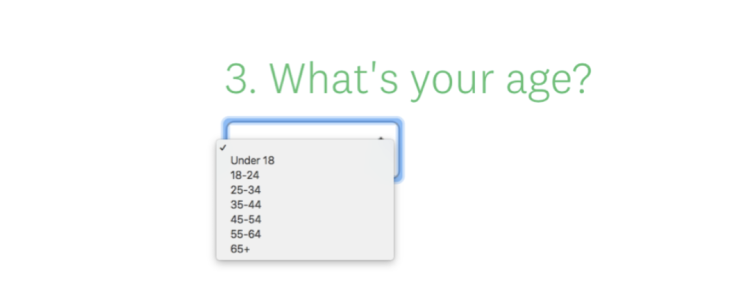
6. Closed-ended demographic questions
Speaking of demographics, most surveys will use demographic questions to gather information for demographic segmentation. These questions give you the option to filter the data you collect based on things like gender, race/ethnicity, income, or marital status.
These closed-ended questions help you uncover any preferences or behaviors within specific groups of people—like if women under age 30 love your product or if single people are more likely to recommend your brand to a friend. You can also use demographic responses to create more targeted surveys down the line, which could boost your response rates.
Here is an example of a closed-ended demographic question:
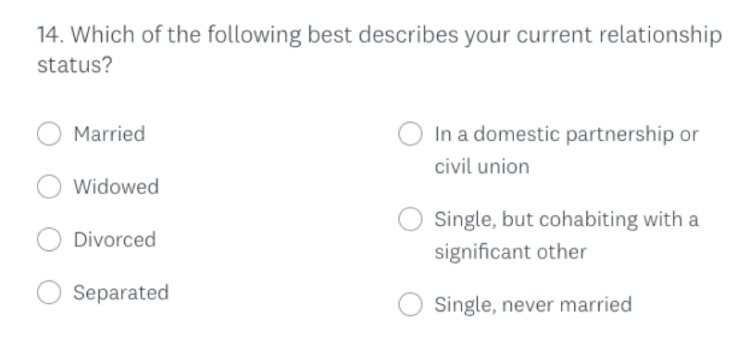
7. Closed-ended ranking questions
A ranking question asks respondents to place several answer options in order of preference or importance, usually in a drag-and-drop format. This can provide you with valuable weighted data; you’ll be able to see how respondents feel about each answer option and understand each option’s relative popularity.
For example, a marketing events team that’s planning a conference might use a ranking question to understand attendees’ top expectations:
Please rank the following in order of importance to your conference experience:
- Networking opportunities
- Workshops and hands-on learning
- Q&As with industry leaders
- Short session formats
- Free registration
8. Closed-ended image choice questions
With image choice questions, the answer options are images. These close-ended question types are especially important when you want to evaluate whether visuals are resonating with people or falling flat.
In market research, image choice questions are essential for logo design testing, package testing, and ad testing.
Here is an example of an image choice question:

9. Closed-ended click map questions
Click map questions are a type of image choice question, but they provide additional context and data. Businesses will commonly use this question type to see which parts of a visual pop, so they can know what catches customers’ eyes on a supermarket shelf or in an online ad.
Here is an example of a click map question:
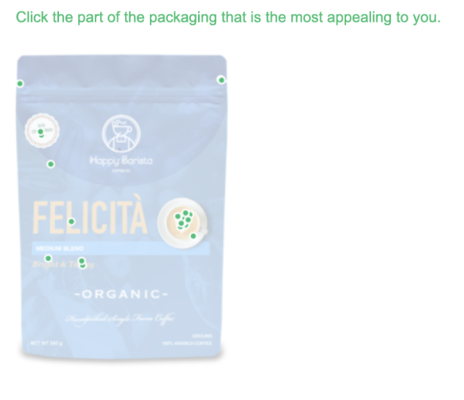
The results from this close-ended question will show exactly which part of the package people like the most.
10. Closed-ended slider questions
Slider questions are a form of rating scale questions where respondents use a slider to indicate their response. As interactive questions, these are useful for breaking up more standard (and potentially repetitive) multiple-choice questions.
Here is an example of a slider question:

What’s the difference between close-ended and open-ended questions?
The difference between closed-ended questions and open-ended questions comes down to whether your question offers pre-determined answer options or a text box where people can share their thoughts or opinions in their own words.
On the plus side, open-ended questions allow for more extensive feedback and give respondents a chance to share personal opinions about a service, product, or experience.
They also allow you to uncover things you may not have considered, but that are important to your customers—which can spark ideas for new close-ended questions.
However, analyzing open-ended questions is not as straightforward as quantitative analysis. For statistically significant results, closed-ended questions are key.
Here’s a quick rundown of close-ended vs. open-ended questions:
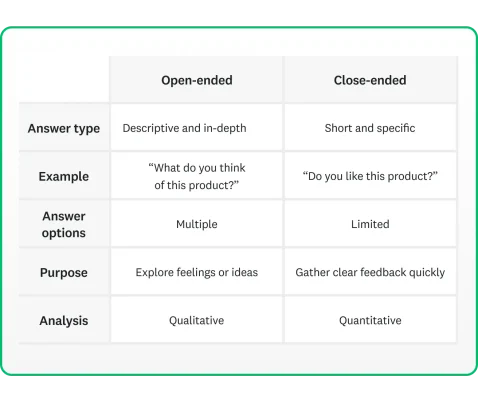
When and why to use close-ended questions
In general, it’s a good idea to ask a mix of closed and open-ended questions so you can get both hard data and the context, or qualitative reasoning, behind it. But how do you know when to focus on closed-ended questions?
Here are a few scenarios when you may want to prioritize close-ended survey questions:
When you have a lot of survey respondents
Although open-ended questions are useful for understanding the “why” behind your data, they usually require a hefty time commitment when it comes to analysis. While sentiment analysis can help you categorize the emotion behind what people are saying, you’ll still probably want to read through open-ended responses. That can quickly become a mammoth task if you’ve got a large sample size.
When dealing with a large respondent pool, it’s more efficient to use close-ended questions where possible. With data analysis tools, you can easily comb through responses and get useful, numerical data.
When you want to prevent or reduce question fatigue
Open-ended questions don’t just eat up analysis time. They also require effort on the respondent side, since people need to consider their experience or opinion and put their thoughts into words. In contrast, a closed-ended question with a Likert scale would simply ask respondents to click on a rating.
Your goal should always be to make sure your surveys aren’t a burden for respondents to complete. Close-ended questions don’t typically take a lot of time to answer, which is good for your survey response rates. And if you do plan to ask open-ended questions, you can use closed-ended questions to break up the format of your survey so the respondent experience doesn’t feel like a slog.
When you need straightforward answers
Closed-ended questions provide the numerical data you need for statistical analysis. Put simply, if you need metrics, you need closed-ended questions.
For example, if your business wants to improve its customer experience, you may run an NPS survey. And as we mentioned earlier, your NPS is based on a single closed-ended question:
“On a scale of 0 to 10, how likely would you be to recommend our company to a friend or colleague?”
The simple mathematical formula that’s used to calculate your NPS couldn’t be applied to results from an open-ended question; the math doesn’t work without quantitative data. The same goes for your Customer Effort Score, another important business metric and a great way to gauge friction in the customer journey.
You can also use closed-ended data for a range of statistical analyses:
- Cluster analysis: A statistical method of organizing groups into clusters based on their association with one another.
- Correlation analysis: Measuring the strength of relation between two variables.
- Hypothesis testing: Tracking changes to close-ended question responses before and after a business implements a change in its customer-facing operations.
- Regression analysis: Establishing or estimating relationships between different variables.
- Survival analysis: Determining customer churn rates based on close-ended data.
When you need data quickly
When it comes to collecting data as rapidly as possible, close-ended questions are the way to go. They take people just a few seconds to answer, paving the way for a higher survey completion rate.
Short, specific, close-ended survey questions are especially useful for quick online polls. Use a poll during a customer webinar or employee town hall to keep attendees engaged and get real-time insights. Or poll your team with a shortlist of activities for your next team-building session. The data you get will come in fast and help you move fast, too.
FAQs: close-ended questions
- What is the main difference between close-ended questions and open-ended questions?
- Are close-ended questions qualitative or quantitative?
- Can I use close-ended questions and open-ended questions in the same survey?
- How do I write a closed-ended question?
Ask better closed-ended questions with SurveyMonkey
When gathering data, you need to make sure that you ask the right questions without overwhelming your respondents. Sometimes, the best question for the job is close-ended—especially if your end goal is statistical analysis.
Want to make sure your close-ended questions will get you results you can actually use? Try out a free survey template, rely on AI for expert question phrasing, and get started with SurveyMonkey today.
Net Promoter, Net Promoter Score, and NPS are trademarks of Satmetrix Systems, Inc., Bain & Company, Inc., and Fred Reichheld.
Discover more resources

The insights manager's secret to delivering quality research
Insights managers can use this toolkit to help you deliver compelling, actionable insights to support stakeholders and reach the right audiences.

SurveyMonkey Research: AI Sentiment Study

The ultimate guide to writing qualitative research questions
Learn how to write effective qualitative research questions that uncover deep insights. Explore types, examples, and tips to craft questions.

How to write a research question
Discover how to write a research question that drives meaningful insights. Follow this step-by-step guide to create impactful questions.